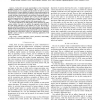27 search results - page 1 / 6 » Optimal Camera Placement for Automated Surveillance Tasks |
JIRS
2007
13 years 4 months ago
2007
— Today, there are many opportunities to create vision-based intelligent systems that are human-centric. This is a very rich area because humans are very complex, and the number ...
TSMC
2010
12 years 11 months ago
2010
Most existing camera placement algorithms focus on coverage and/or visibility analysis, which ensures that the object of interest is visible in the camera's field of view (FOV...
AVSS
2005
IEEE
13 years 10 months ago
2005
IEEE
The performance of computer vision systems for measurement, surveillance, reconstruction, gait recognition, and many other applications, depends heavily on the placement of camera...
CVPR
1999
IEEE
14 years 6 months ago
1999
IEEE
The task of multi-camera surveillance is to reconstruct the paths taken by all moving objects that are temporarily visible from multiple non-overlapping cameras. We present a Baye...
MM
2005
ACM
13 years 10 months ago
2005
ACM
Large-scale distributed video surveillance systems pose new scalability challenges. Due to the large number of video sources in such systems, the amount of bandwidth required to t...


